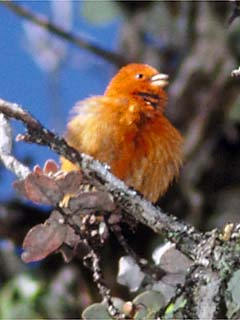
All 'Akepa have an unusual cross-bill. When closed, the upper bill tip slightly overlaps the lower bill tip to one side (this cannot be seen in the field). When opening the bill, as in prying open leaf buds to extract small caterpillars, the bills swing dramatically sideways, and this is easily seen in the hand. Some birds cross one way, and some the other, apparently randomly. The ʻAkepa cross-bill operates similarly to that in the North American crossbills (genus Loxia), but is much less obvious when the bill is closed.
ʻAkepa are usually found from 1,500 to 2,200 meters above sea level.
wikipedia